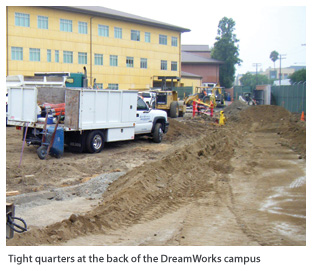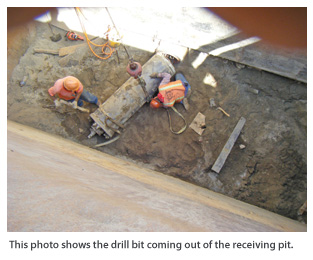A “Dream” Job
 Tight timelines, a spaghetti mesh of existing utilities in the area, a cooling tower, electrical power vaults, buildings on the very edge of the easement that left no room for equipment or staging, parallel construction of an adjacent four-story story building and fiber optics that fed one of the most highly recruited and high profile companies in the country — DreamWorks. This job had it all.
Tight timelines, a spaghetti mesh of existing utilities in the area, a cooling tower, electrical power vaults, buildings on the very edge of the easement that left no room for equipment or staging, parallel construction of an adjacent four-story story building and fiber optics that fed one of the most highly recruited and high profile companies in the country — DreamWorks. This job had it all.
As a part of ongoing sewer system upgrades, the City of Glendale, Calif., planned to abandon the existing sewer line in the DreamWorks studio campus in favor of a new, larger, relocated line, approximately 40 ft to the west. In this congested urban campus, the options for routing the new line weren’t good, but after two years of negotiating the new easement, there was no going back. The Victory Truck Boulevard Wastewater Capacity Improvement project called for both open-cut and trenchless installations (both pilot tube and jack-and-bore methods), with a final depth of 20 ft, but one section of the project created some exceptional demands.
The plan called for the new line to follow the contour of the Los Angeles River (LA River) between the river and the DreamWorks Studios. The timeline had no room for delays because a new DreamWorks Studio Animation Building was slated to be built as soon as possible after the old line was abandoned (the new building was intended to be placed on top of the old sewer line). Construction of the animation building and the sewer line were to run concurrently. The addition of the building construction eliminated over half the available working space and further restricted access to the site.
Pipe Selection
The tight timelines, lack of room for equipment and concerns about existing utilities all pointed to using pilot tube microtunneling (PTMT). This method provides a very accurate (within ¼-in. up to 300 lf) installation with very little surface disruption. Because of the sensitive nature of some of the DreamWorks equipment and the exacting nature of their work, even excessive sub-surface vibration would have created unacceptable productivity loss.
Jasmina Zigic, P.E., project manager for the City of Glendale, said, “We considered other materials, but the people at the National Clay Pipe Institute provided all of the information and documentation we needed to evaluate and specify clay pipe for both the open-cut and the trenchless parts of the installation.”
“Some people still aren’t aware that clay pipe can be used in this kind of installation,” according to Joe Parker, vice president of technical services for the National Clay Pipe Institute (NCPI). “But we were able to work with the city to demonstrate the efficacy of VCP in this setting.”
Both the installation method and the ability to eliminate the external casing pipe were advantages for vitrified clay pipe (VCP). Because of its high-compressive strength (18,000 psi on average), leak-free joints and affordability, VCP is the predominant pipe material used in PTMT.
The soil borings showed fill soils, 2 to 18 ft. The fill soils consisted of silty sand and were uniformly well compacted. The underlying natural soils consist of stiff to very stiff silt medium dense silty sand and medium dense to very dense poorly graded sand and well graded sand.
“This job was another reminder that you should always be prepared for the unexpected,” said Parker. “In the midst of the job, we unexpectedly came across a boulder at a location that could not be potholed for retrieval. The boulder damaged the powered cutter head (PCH), causing a leak in the hydraulic fluid line. Luckily, this occurred at the last trenchless installation. To complete the installation, the contractor switched to biodegradable oil to be able to continue boring without contaminating the groundwater.”
The jacking and receiving shafts were just 8 ft in diameter. During the installation process, spoil was displaced by the slant-faced steering head. The pilot tube was directed on line and on grade by rotation during advancement. The operator’s skill was critical in identifying unexpected or out of place utilities. DreamWorks became an important part of the team in identifying the active utilities and helping to keep the project on schedule.
 In PTMT installations, the hollow stem of the pilot tube creates the optical path for the camera to view the LED target in the steering head displaying the head position and steering orientation. The pilot tube line establishes the centerline for the new sewer.
In PTMT installations, the hollow stem of the pilot tube creates the optical path for the camera to view the LED target in the steering head displaying the head position and steering orientation. The pilot tube line establishes the centerline for the new sewer.
The bore is then increased by the installation of a reaming head followed by augers in casings, which transport the spoil to the jacking shaft for removal.
The final step to increase the bore used a PCH, advanced by the product pipe, which transports the spoils into the receiving shaft.
“The challenges on this site made this an exceptional installation,” according to Zigic, “but it all worked quite well. We won’t have any hesitation about using this method and VCP again.”
“The team effort on this job was impressive,” according to Parker. “At every step of the way, the City of Glendale, their contractors and sub-contractors and DreamWorks staff all seemed to understand that the nature of this job demanded a first-rate team. And they all came through.”
Mike Van Dine is president of the National Clay Pipe Institute, a non-profit technical resource for design, installation and operation of vitrified clay pipe (VCP) gravity sewer systems. Established in 1944, NCPI is the authoritative resource for civil engineers and contractors designing, specifying and installing VCP sanitary sewer systems.
![]()
